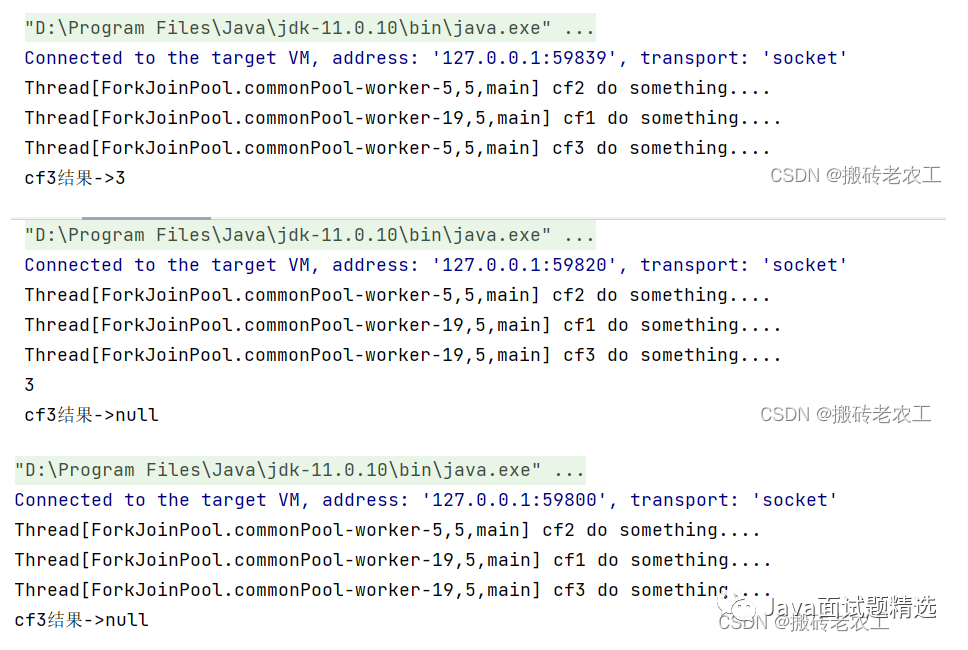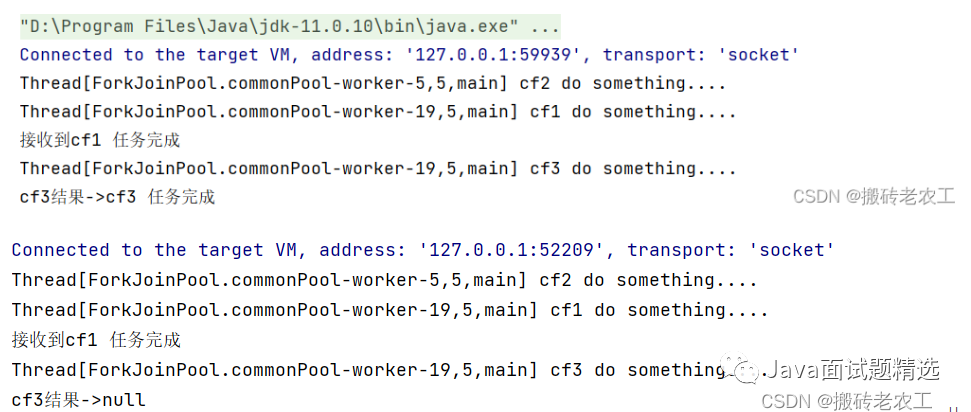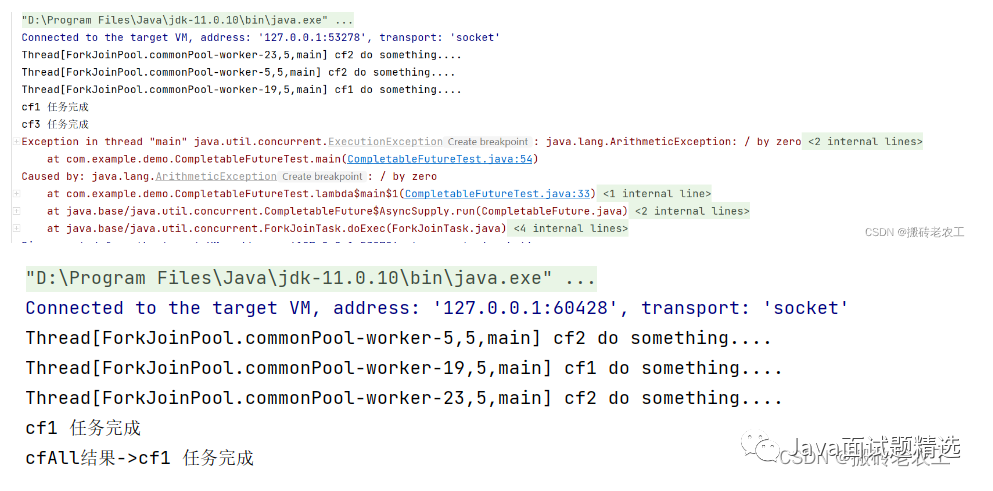Java8异步利器:CompletableFuture全网最全使用教程
阅读本文大概需要 11 分钟。
来自:blog.csdn.net/zsx_xiaoxin/article/details/123898171
CompletableFuture是jdk8的新特性。CompletableFuture实现了CompletionStage接口和Future接口,前者是对后者的一个扩展,增加了异步会点、流式处理、多个Future组合处理的能力,使Java在处理多任务的协同工作时更加顺畅便利。一、创建异步任务
1. supplyAsync
supplyAsync是创建带有返回值的异步任务。它有如下两个方法,一个是使用默认线程池(ForkJoinPool.commonPool())的方法,一个是带有自定义线程池的重载方法// 带返回值异步请求,默认线程池
public static <U> CompletableFuture<U> supplyAsync(Supplier<U> supplier)
// 带返回值的异步请求,可以自定义线程池
public static <U> CompletableFuture<U> supplyAsync(Supplier<U> supplier, Executor executor)
public static void main(String[] args) throws ExecutionException, InterruptedException {
CompletableFuture<String> cf = CompletableFuture.supplyAsync(() -> {
System.out.println("do something....");
return "result";
});
//等待任务执行完成
System.out.println("结果->" + cf.get());
}
public static void main(String[] args) throws ExecutionException, InterruptedException {
// 自定义线程池
ExecutorService executorService = Executors.newSingleThreadExecutor();
CompletableFuture<String> cf = CompletableFuture.supplyAsync(() -> {
System.out.println("do something....");
return "result";
}, executorService);
//等待子任务执行完成
System.out.println("结果->" + cf.get());
}

2. runAsync
ForkJoinPool.commonPool())的方法,一个是带有自定义线程池的重载方法// 不带返回值的异步请求,默认线程池
public static CompletableFuture<Void> runAsync(Runnable runnable)
// 不带返回值的异步请求,可以自定义线程池
public static CompletableFuture<Void> runAsync(Runnable runnable, Executor executor)
public static void main(String[] args) throws ExecutionException, InterruptedException {
CompletableFuture<Void> cf = CompletableFuture.runAsync(() -> {
System.out.println("do something....");
});
//等待任务执行完成
System.out.println("结果->" + cf.get());
}
public static void main(String[] args) throws ExecutionException, InterruptedException {
// 自定义线程池
ExecutorService executorService = Executors.newSingleThreadExecutor();
CompletableFuture<Void> cf = CompletableFuture.runAsync(() -> {
System.out.println("do something....");
}, executorService);
//等待任务执行完成
System.out.println("结果->" + cf.get());
}

3.获取任务结果的方法
// 如果完成则返回结果,否则就抛出具体的异常
public T get() throws InterruptedException, ExecutionException
// 最大时间等待返回结果,否则就抛出具体异常
public T get(long timeout, TimeUnit unit) throws InterruptedException, ExecutionException, TimeoutException
// 完成时返回结果值,否则抛出unchecked异常。为了更好地符合通用函数形式的使用,如果完成此 CompletableFuture所涉及的计算引发异常,则此方法将引发unchecked异常并将底层异常作为其原因
public T join()
// 如果完成则返回结果值(或抛出任何遇到的异常),否则返回给定的 valueIfAbsent。
public T getNow(T valueIfAbsent)
// 如果任务没有完成,返回的值设置为给定值
public boolean complete(T value)
// 如果任务没有完成,就抛出给定异常
public boolean completeExceptionally(Throwable ex)
二、异步回调处理
1.thenApply和thenApplyAsync
public static void main(String[] args) throws ExecutionException, InterruptedException {
CompletableFuture<Integer> cf1 = CompletableFuture.supplyAsync(() -> {
System.out.println(Thread.currentThread() + " cf1 do something....");
return 1;
});
CompletableFuture<Integer> cf2 = cf1.thenApplyAsync((result) -> {
System.out.println(Thread.currentThread() + " cf2 do something....");
result += 2;
return result;
});
//等待任务1执行完成
System.out.println("cf1结果->" + cf1.get());
//等待任务2执行完成
System.out.println("cf2结果->" + cf2.get());
}
public static void main(String[] args) throws ExecutionException, InterruptedException {
CompletableFuture<Integer> cf1 = CompletableFuture.supplyAsync(() -> {
System.out.println(Thread.currentThread() + " cf1 do something....");
return 1;
});
CompletableFuture<Integer> cf2 = cf1.thenApply((result) -> {
System.out.println(Thread.currentThread() + " cf2 do something....");
result += 2;
return result;
});
//等待任务1执行完成
System.out.println("cf1结果->" + cf1.get());
//等待任务2执行完成
System.out.println("cf2结果->" + cf2.get());
}


thenApplyAsync在子任务中是另起一个线程执行任务,并且thenApplyAsync可以自定义线程池,默认的使用ForkJoinPool.commonPool()线程池。2.thenAccept和thenAcceptAsync
public static void main(String[] args) throws ExecutionException, InterruptedException {
CompletableFuture<Integer> cf1 = CompletableFuture.supplyAsync(() -> {
System.out.println(Thread.currentThread() + " cf1 do something....");
return 1;
});
CompletableFuture<Void> cf2 = cf1.thenAccept((result) -> {
System.out.println(Thread.currentThread() + " cf2 do something....");
});
//等待任务1执行完成
System.out.println("cf1结果->" + cf1.get());
//等待任务2执行完成
System.out.println("cf2结果->" + cf2.get());
}
public static void main(String[] args) throws ExecutionException, InterruptedException {
CompletableFuture<Integer> cf1 = CompletableFuture.supplyAsync(() -> {
System.out.println(Thread.currentThread() + " cf1 do something....");
return 1;
});
CompletableFuture<Void> cf2 = cf1.thenAcceptAsync((result) -> {
System.out.println(Thread.currentThread() + " cf2 do something....");
});
//等待任务1执行完成
System.out.println("cf1结果->" + cf1.get());
//等待任务2执行完成
System.out.println("cf2结果->" + cf2.get());
}


thenAccep和thenAccepAsync区别在于,使用thenAccep方法时子任务与父任务使用的是同一个线程,而thenAccepAsync在子任务中可能是另起一个线程执行任务,并且thenAccepAsync可以自定义线程池,默认的使用ForkJoinPool.commonPool()线程池。3.thenRun和thenRunAsync
public static void main(String[] args) throws ExecutionException, InterruptedException {
CompletableFuture<Integer> cf1 = CompletableFuture.supplyAsync(() -> {
System.out.println(Thread.currentThread() + " cf1 do something....");
return 1;
});
CompletableFuture<Void> cf2 = cf1.thenRun(() -> {
System.out.println(Thread.currentThread() + " cf2 do something....");
});
//等待任务1执行完成
System.out.println("cf1结果->" + cf1.get());
//等待任务2执行完成
System.out.println("cf2结果->" + cf2.get());
}
public static void main(String[] args) throws ExecutionException, InterruptedException {
CompletableFuture<Integer> cf1 = CompletableFuture.supplyAsync(() -> {
System.out.println(Thread.currentThread() + " cf1 do something....");
return 1;
});
CompletableFuture<Void> cf2 = cf1.thenRunAsync(() -> {
System.out.println(Thread.currentThread() + " cf2 do something....");
});
//等待任务1执行完成
System.out.println("cf1结果->" + cf1.get());
//等待任务2执行完成
System.out.println("cf2结果->" + cf2.get());
}


thenRunAsync区别在于,使用thenRun方法时子任务与父任务使用的是同一个线程,而thenRunAsync在子任务中可能是另起一个线程执行任务,并且thenRunAsync可以自定义线程池,默认的使用ForkJoinPool.commonPool()线程池。4.whenComplete和whenCompleteAsync
whenComplete是当某个任务执行完成后执行的回调方法,会将执行结果或者执行期间抛出的异常传递给回调方法,如果是正常执行则异常为null,回调方法对应的CompletableFuture的result和该任务一致,如果该任务正常执行,则get方法返回执行结果,如果是执行异常,则get方法抛出异常。public static void main(String[] args) throws ExecutionException, InterruptedException {
CompletableFuture<Integer> cf1 = CompletableFuture.supplyAsync(() -> {
System.out.println(Thread.currentThread() + " cf1 do something....");
int a = 1/0;
return 1;
});
CompletableFuture<Integer> cf2 = cf1.whenComplete((result, e) -> {
System.out.println("上个任务结果:" + result);
System.out.println("上个任务抛出异常:" + e);
System.out.println(Thread.currentThread() + " cf2 do something....");
});
// //等待任务1执行完成
// System.out.println("cf1结果->" + cf1.get());
// //等待任务2执行完成
System.out.println("cf2结果->" + cf2.get());
}

whenCompleteAsync和whenComplete区别也是whenCompleteAsync可能会另起一个线程执行任务,并且thenRunAsync可以自定义线程池,默认的使用ForkJoinPool.commonPool()线程池。5.handle和handleAsync
public static void main(String[] args) throws ExecutionException, InterruptedException {
CompletableFuture<Integer> cf1 = CompletableFuture.supplyAsync(() -> {
System.out.println(Thread.currentThread() + " cf1 do something....");
// int a = 1/0;
return 1;
});
CompletableFuture<Integer> cf2 = cf1.handle((result, e) -> {
System.out.println(Thread.currentThread() + " cf2 do something....");
System.out.println("上个任务结果:" + result);
System.out.println("上个任务抛出异常:" + e);
return result+2;
});
//等待任务2执行完成
System.out.println("cf2结果->" + cf2.get());
}

三、多任务组合处理
1.thenCombine、thenAcceptBoth 和runAfterBoth
CompletableFuture组合起来处理,只有两个任务都正常完成时,才进行下阶段任务。thenCombine会将两个任务的执行结果作为所提供函数的参数,且该方法有返回值;thenAcceptBoth同样将两个任务的执行结果作为方法入参,但是无返回值;runAfterBoth没有入参,也没有返回值。注意两个任务中只要有一个执行异常,则将该异常信息作为指定任务的执行结果。public static void main(String[] args) throws ExecutionException, InterruptedException {
CompletableFuture<Integer> cf1 = CompletableFuture.supplyAsync(() -> {
System.out.println(Thread.currentThread() + " cf1 do something....");
return 1;
});
CompletableFuture<Integer> cf2 = CompletableFuture.supplyAsync(() -> {
System.out.println(Thread.currentThread() + " cf2 do something....");
return 2;
});
CompletableFuture<Integer> cf3 = cf1.thenCombine(cf2, (a, b) -> {
System.out.println(Thread.currentThread() + " cf3 do something....");
return a + b;
});
System.out.println("cf3结果->" + cf3.get());
}
public static void main(String[] args) throws ExecutionException, InterruptedException {
CompletableFuture<Integer> cf1 = CompletableFuture.supplyAsync(() -> {
System.out.println(Thread.currentThread() + " cf1 do something....");
return 1;
});
CompletableFuture<Integer> cf2 = CompletableFuture.supplyAsync(() -> {
System.out.println(Thread.currentThread() + " cf2 do something....");
return 2;
});
CompletableFuture<Void> cf3 = cf1.thenAcceptBoth(cf2, (a, b) -> {
System.out.println(Thread.currentThread() + " cf3 do something....");
System.out.println(a + b);
});
System.out.println("cf3结果->" + cf3.get());
}
public static void main(String[] args) throws ExecutionException, InterruptedException {
CompletableFuture<Integer> cf1 = CompletableFuture.supplyAsync(() -> {
System.out.println(Thread.currentThread() + " cf1 do something....");
return 1;
});
CompletableFuture<Integer> cf2 = CompletableFuture.supplyAsync(() -> {
System.out.println(Thread.currentThread() + " cf2 do something....");
return 2;
});
CompletableFuture<Void> cf3 = cf1.runAfterBoth(cf2, () -> {
System.out.println(Thread.currentThread() + " cf3 do something....");
});
System.out.println("cf3结果->" + cf3.get());
}

2.applyToEither、acceptEither和runAfterEither
CompletableFuture组合起来处理,当有一个任务正常完成时,就会进行下阶段任务。applyToEither会将已经完成任务的执行结果作为所提供函数的参数,且该方法有返回值;acceptEither同样将已经完成任务的执行结果作为方法入参,但是无返回值;runAfterEither没有入参,也没有返回值。
acceptEither和runAfterEither类似,acceptEither会将cf1任务的结果作为cf3任务的入参,但cf3任务完成时并无返回值;runAfterEither不会将cf1任务的结果作为cf3任务的入参,它是没有任务入参,执行完自己的任务后也并无返回值。3.allOf / anyOf
CompletableFuture执行get方法时会抛出异常,如果都是正常执行,则get返回null。CompletableFuture执行get方法时会抛出异常,如果都是正常执行,则get返回执行完成任务的结果。public static void main(String[] args) throws ExecutionException, InterruptedException {
CompletableFuture<String> cf1 = CompletableFuture.supplyAsync(() -> {
try {
System.out.println(Thread.currentThread() + " cf1 do something....");
Thread.sleep(2000);
} catch (InterruptedException e) {
e.printStackTrace();
}
System.out.println("cf1 任务完成");
return "cf1 任务完成";
});
CompletableFuture<String> cf2 = CompletableFuture.supplyAsync(() -> {
try {
System.out.println(Thread.currentThread() + " cf2 do something....");
int a = 1/0;
Thread.sleep(5000);
} catch (InterruptedException e) {
e.printStackTrace();
}
System.out.println("cf2 任务完成");
return "cf2 任务完成";
});
CompletableFuture<String> cf3 = CompletableFuture.supplyAsync(() -> {
try {
System.out.println(Thread.currentThread() + " cf2 do something....");
Thread.sleep(3000);
} catch (InterruptedException e) {
e.printStackTrace();
}
System.out.println("cf3 任务完成");
return "cf3 任务完成";
});
CompletableFuture<Void> cfAll = CompletableFuture.allOf(cf1, cf2, cf3);
System.out.println("cfAll结果->" + cfAll.get());
}
public static void main(String[] args) throws ExecutionException, InterruptedException {
CompletableFuture<String> cf1 = CompletableFuture.supplyAsync(() -> {
try {
System.out.println(Thread.currentThread() + " cf1 do something....");
Thread.sleep(2000);
} catch (InterruptedException e) {
e.printStackTrace();
}
System.out.println("cf1 任务完成");
return "cf1 任务完成";
});
CompletableFuture<String> cf2 = CompletableFuture.supplyAsync(() -> {
try {
System.out.println(Thread.currentThread() + " cf2 do something....");
Thread.sleep(5000);
} catch (InterruptedException e) {
e.printStackTrace();
}
System.out.println("cf2 任务完成");
return "cf2 任务完成";
});
CompletableFuture<String> cf3 = CompletableFuture.supplyAsync(() -> {
try {
System.out.println(Thread.currentThread() + " cf2 do something....");
Thread.sleep(3000);
} catch (InterruptedException e) {
e.printStackTrace();
}
System.out.println("cf3 任务完成");
return "cf3 任务完成";
});
CompletableFuture<Object> cfAll = CompletableFuture.anyOf(cf1, cf2, cf3);
System.out.println("cfAll结果->" + cfAll.get());
}

推荐阅读:
阿里技术面:每天100w次登陆请求, 8G 内存该如何设置JVM参数?
互联网初中高级大厂面试题(9个G) 内容包含Java基础、JavaWeb、MySQL性能优化、JVM、锁、百万并发、消息队列、高性能缓存、反射、Spring全家桶原理、微服务、Zookeeper......等技术栈!
⬇戳阅读原文领取! 朕已阅


